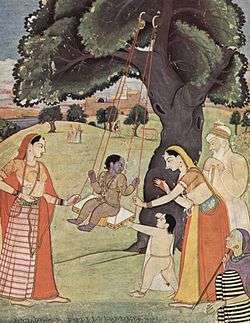Hindu Ghosi
The Hindu Ghosi also spelled Ghosee trace their origin to King Nand, the professed ancestor of Yaduvanshi Ahirs.
| Hindu Ghosi | |
|---|---|
| Religions | Hinduism |
| Languages | Hindi, Bhojpuri,Maithali Brajbhasha and Ahirwati |
| Populated states | Near Delhi, Ahirwal, Uttar Pradesh, Madhya Pradesh ,Bihar and Nepal |
| Subdivisions | Krishnavanshi or Yaduvanshi Ahir Phatak Ghosin Yadav |
Myth of origin
They also claim their importance saying that the sacred texts have mentioned them under the name of Ghosas.[1] The term Ghosa refers to a settlement of the Abhira people[2] or a temporary encampment of cowherds, which was the occupation of those people.[3]
Colonial description

The largest subdivisions of Ahirs in Braj-Ahirwal area are the Ghosi, Kamariya, Phataks and Nandvanshis. However today they all recognise themselves to be Yaduvanshi or Krishnavanshi Yadavs.[4]
In the Braj-Ahirwal region, the Ghosi and other subdivisions of Ahirs were gradually absorbed into the Nandvanshi category of landlords and into the Yaduvanshi subdivision as a consequence of British so-called "official" ethnographies and racial theories. The landlords liked the Nandvanshi title because they considered it to be prestigious.[5]
Distribution
In the Braj-Ahirwal area, the Ghosi are among the largest Ahir subdivisions, along with the Kamariyas, Gwalvanshis and Nandvanshis.[6]
See also
References
- Michelutti, Lucia (2002). Sons of Krishna: the politics of Yadav community formation in a North Indian town (PDF). London School of Economics and Political Science University of London. pp. 94, 95. Retrieved 15 March 2016.
- Roy, Janmajit (2002). Theory of Avatāra and Divinity of Chaitanya. Atlantic Publishers & Dist. p. 157. ISBN 978-8-12690-169-2.
- Bhattacharya, Sunil Kumar (1996). Krishna-cult in Indian Art. M.D. Publications. p. 126. ISBN 978-8-17533-001-6.
- Lucia, Michelutti (2002). Sons of Krishna: the politics of Yadav (PDF). London School of Economics and Political Science,University of London. p. 96. Retrieved 12 October 2016.
- Michelutti, Lucia (2002). "Sons of Krishna: the politics of Yadav community formation in a North Indian town" (PDF). PhD Thesis Social Anthropology. London School of Economics and Political Science University of London. pp. 90–91, 95. Retrieved 27 May 2015.
- Michelutti, Lucia (2002). "Sons of Krishna: the politics of Yadav community formation in a North Indian town" (PDF). PhD Thesis Social Anthropology. London School of Economics and Political Science University of London. p. 93. Retrieved 27 May 2015.